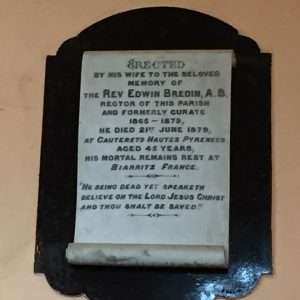On the wall of Saint Andrew’s Church in the Co Laois town of Rathdowney, there is a memorial tablet to a former incumbent. Such memorials to rectors are common, but a memorial to a rector who died in the Pyrenees must be something unique. The tablet gives no information regarding the circumstances of the unfortunate Mr Bredin’s death:
ERECTED
BY HIS WIFE TO THE BELOVED
MEMORY OF
THE REV EDWIN BREDIN A.B.
RECTOR OF THIS PARISH
AND FORMERLY CURATE
1865-1879
HE DIED 21ST JUNE 1879
AT CAUTERETS HAUTES PYRENEES
AGED 45 YEARS
HIS MORTAL REMAINS REST AT
BIARRITZ, FRANCE
_____________
“HE BEING DEAD YET SPEAKETH
BELIEVE ON THE LORD JESUS CHRIST
AND THOU SHALT BE SAVED”
Perhaps there would be some clue as to what happened in”Clergy of Ossory,” a weighty tome providing biographical notes on centuries of clergy. Its entry on Edwin Bredin has a paucity of detail.
1873—Edwin Bredin inst. July 17 (S.R.). Son of Rev. James B., R. of Myshall; T.C.D. BA. 1859, Div. Test. 1860; ord. D. 23 Dec., 1860 (Oss), P. Dec, 1861 (Cashel); C. Myshall 1861, C. Ratbdowney 1865-73, C. Rathkyran 1869; m. April 8, 1874, Mary, eldest dau. of Robert Field of Banbury ; d. 21 June, Exrix. Mrs Mary Fish Bredin
An Internet search provided little more by way of information. Bredin was not one of those rich clergy who could afford to pay a curate while he himself passed much of the year in the sunshine. The value of the living is recorded as being £115 per annum, not the sort of income that allowed one to be an absentee parson who lived in Biarritz.
Notes on the Goodreads website ,on the writer E.M. Channon, Bredin’s daughter, offer some clues about the family’s circumstances:
Born in 1875, in Rathdowney, Ireland, Ethel Mary Bredin was the daughter of the Rev. Edwin Bredin. Upon the death of her father, when she was four years old, Bredin and mother went to live with relations in England. She was educated at St. Leonard’s Ladies’ College, and for one year, at Cheltenham Ladies’ College. In 1904, she married the Rev. Francis Granville Channon, and settled with him at Eton, where he spent most of his working life. They had six children. Channon began to write and published after she was married, for the pleasure of it, and to supplement the family income. She retired, with Rev. Channon, to Bucknell, Shropshire, in 1932, and died there, in 1941.
Bredin was obviously not a man of such substantial private means that his wife could continue to live independently after his death, so how did he come to be in the Pyrenees in times when few clergy would have travelled outside of the country?
Cauterets is now a spa town and ski station, in Bredin’s time it was at the height of its fame as a spa; Napoleon III and the Empress Eugenie had visited some twenty years prior to his visit. The town had been reached by the railway in 1871 and its hotels had the elegance of the Belle Époque. But what took Bredin there?
Had he spent much of his modest income journeying in search of a cure? Had he suffered respiratory illness that might have found relief among the air and waters of the Pyrenees? Why did no-one think to record on the plaque why he had made that last fateful journey?
